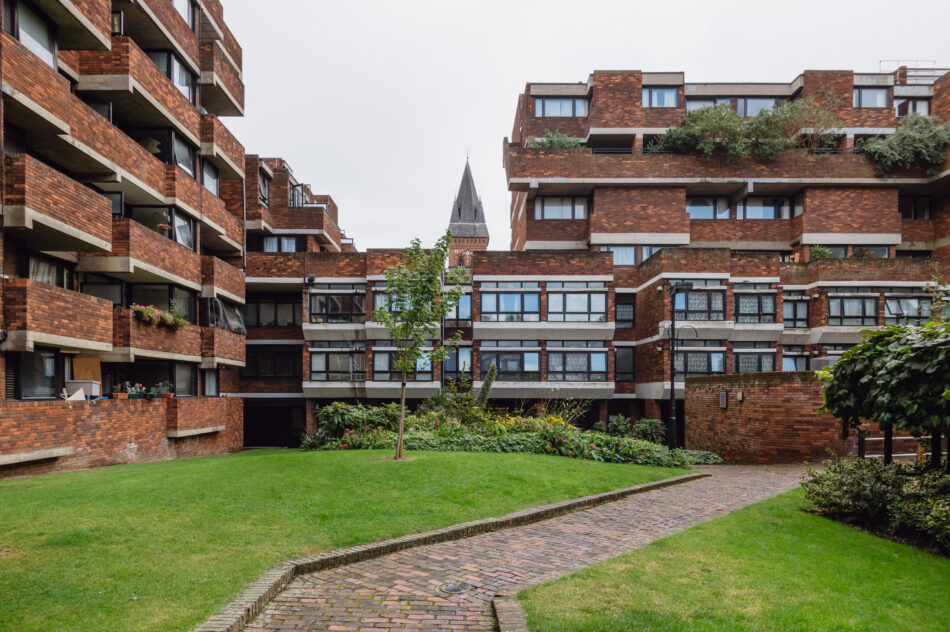



























Repton House
Charlwood Street, London SW1
Architect: Darbourne & Darke
Register for similar homes“Lillington Gardens was epoch making” - English Heritage
This exceptional Grade II*-listed three-bedroom flat is positioned within Darbourne and Darke’s award-winning Lillington Gardens Estate in Pimlico. In their work here, the architects took a radical approach to low-rise, high-density social housing that influenced architecture throughout the UK from the 1960s to the ’80s. For more information on Lillington Gardens Estate, please see the History section below.
In this apartment, the current owners have gone to tremendous lengths to preserve and restore the original mid-century features, including the sliding doors that separate the main bedroom on the lower level from the living areas on the upper floor. The flat looks over the estate’s exceptional landscaping and gardens from the living area and its south-facing terrace.
The Architect
Upon winning a prestigious housing competition to build the Lillington Gardens Estate, John Darbourne (1935-91) invited Geoffrey Darke (1929-2011) to form a partnership in 1961. After the success of the estate, Darke concentrated on housing work while Darbourne expanded into designing laboratories, offices, a stand for Chelsea FC and the landscaping of Heathrow Airport. Throughout the 1970s, the pair’s housing in Stuttgart, Hanover and Bolzano won international accolades.
The Tour
The flat is positioned on the first floor of Repton House and is accessed via an elevated, brick-paved communal walkway. The home has been built in a scissor formation – an interlocking building design developed in the 1950s by David Gregory-Jones and LCC Architects, which uses its unique layout to create split-level living areas.
The front door opens to a cloakroom area with bamboo flooring underfoot, where a short staircase leads to a wonderful L-shaped living space that perfectly encapsulates Darbourne and Darke’s considered design. Natural light pours through the dark-stained timber double-glazed windows at the front of the plan, which can rotate 360 degrees. Adjacent to the living area is a bespoke kitchen designed by Uncommon Projects, with new appliances and Corian work surfaces. The sensitive use of ply and cork echoes the apartment’s original mid-century aesthetic.
A wonderfully bright double bedroom lies on this level, with far-reaching views over the verdant gardens beyond. There is also a sizeable family bathroom and a separate WC. Two further bedrooms can be found on the floor below; both are flooded with natural light. The sliding doors in the main bedroom can be left open to reveal the living spaces above, creating a wonderful sense of flow between the split levels.
Outdoor Space
Leading seamlessly from the living spaces, behind a wall of glazing, lies a south-facing terrace with views across the beautifully landscaped gardens. There are mature trees, a frog pond, multiple seating areas and winding pathways through to the Grade I-listed Church of St James the Less.
The Area
Lillington Gardens is located in Pimlico, which is characterised by its village-like atmosphere and charming cafes, restaurants and independent shops. Tate Britain is only a 10-minute walk away. Green space can be found a few minutes’ walk south in the beautiful St George’s Square, which leads directly onto the Pimlico Garden and the Shrubbery, a peaceful park directly overlooking the River Thames.
Slightly further west is Ranelagh Gardens, an extensive 18th-century set of gardens and lawns which is home to the Chelsea Flower Show. The house is within easy reach of Battersea Park, as well as the shops and restaurants of Victoria, Chelsea and Belgravia.
There are outstanding transport links within close proximity. Pimlico (Victoria Line) is a five-minute walk, while Victoria station offers mainline rail services including direct trains to Gatwick Airport.
Tenure: Leasehold
Lease Length: approx. 147 years remaining
Service Charge: approx. £3,300 per annum (please note the service charge includes unlimited hot water)
Council Tax Band: E
Please note that all areas, measurements and distances given in these particulars are approximate and rounded. The text, photographs and floor plans are for general guidance only. The Modern House has not tested any services, appliances or specific fittings — prospective purchasers are advised to inspect the property themselves. All fixtures, fittings and furniture not specifically itemised within these particulars are deemed removable by the vendor.




History
Lillington Gardens Estate was constructed in three phases between 1961 and 1972. The design took its cue from the striking Victorian red brick of the Grade I-listed Church of St James the Less, which the estate surrounds. This source of inspiration was unusual in the 1960s, but the brown Hastings-made red brick and staggered terraces swiftly became part of what makes Lillington Gardens so iconic.
In their work at Lillington Gardens, Darbourne and Darke explored the combination of brick and concrete with an intensity of tone and complexity of form that had never been achieved before. The design broke with the trend for standard units in high-rise blocks, instead emphasising the individuality of group dwellings and achieving high densities with eight-storey blocks. The general plan of the building is described by Pevsner as “ingenious”, with “internal courtyards and cross-wings threaded through with paths and ramps. [The] higher levels are reached by brick-paved internal streets.”
Lillington Gardens initially housed 2,000 people within its grounds, which also included a pub, grocery shops, surgeries, a community hall and a library. The scheme won a Housing Design award in 1969, a Ministry of Housing and Local Government award for good design in 1970, a RIBA Architecture Award in 1970 and a further RIBA commendation in 1973.
In 1998, English Heritage granted Repton House a Grade II* listing in recognition of its special architectural and historical significance.
























